Porter’s Five Forces Analysis for Timbre Group in Singapore and China
VerifiedAdded on 2023/06/15
|10
|2038
|268
AI Summary
This article provides a Porter’s Five Forces Analysis for Timbre Group, a music lifestyle corporation operating in food and beverage, music education businesses, concerts, and festivals promotion. The analysis explores the competitive position of Timbre Group in Singapore and China, covering the threat of new entrants, substitute products, bargaining power of buyers and suppliers, and rivalry among existing competitors.
Contribute Materials
Your contribution can guide someone’s learning journey. Share your
documents today.
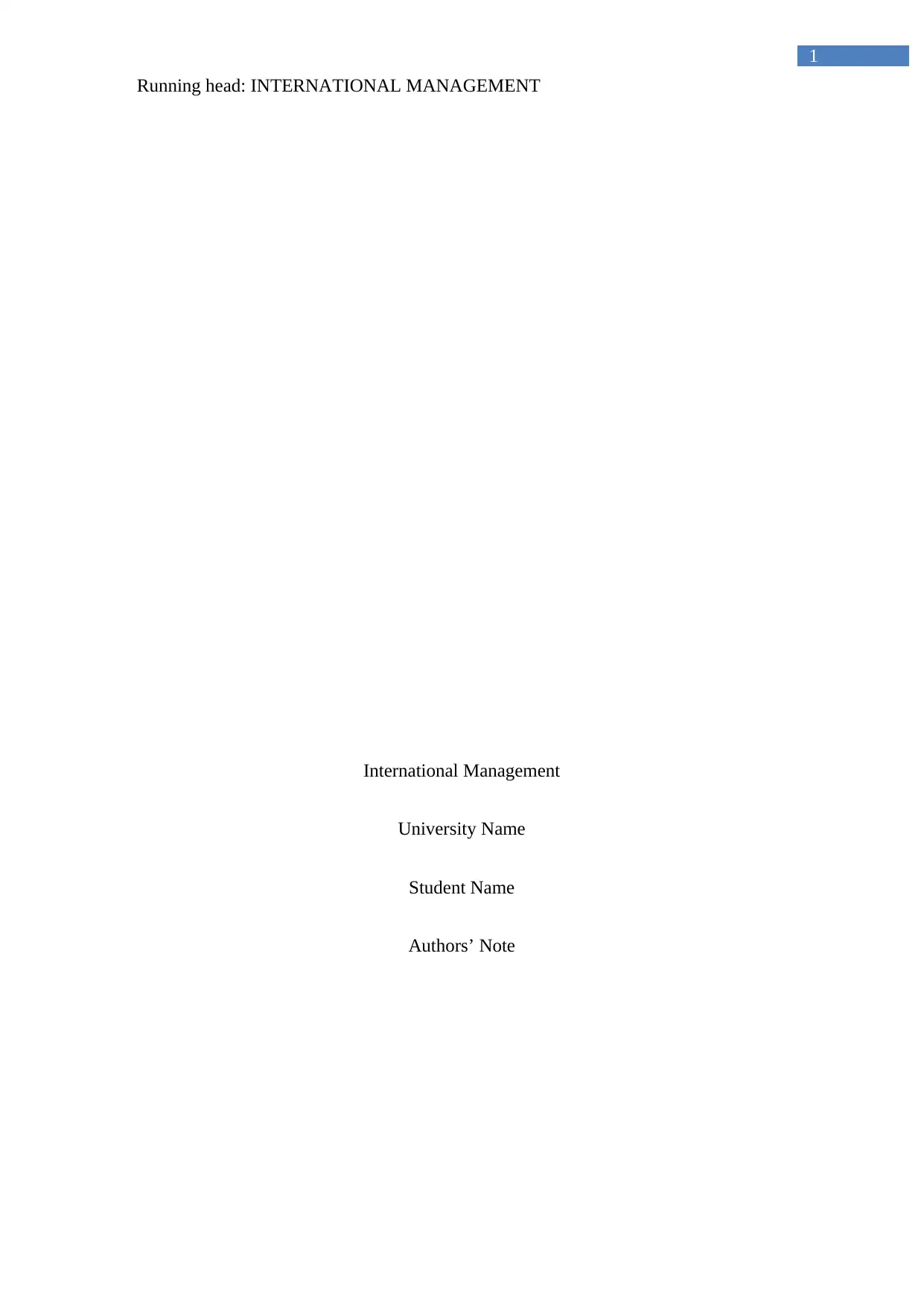
1
Running head: INTERNATIONAL MANAGEMENT
International Management
University Name
Student Name
Authors’ Note
Running head: INTERNATIONAL MANAGEMENT
International Management
University Name
Student Name
Authors’ Note
Secure Best Marks with AI Grader
Need help grading? Try our AI Grader for instant feedback on your assignments.
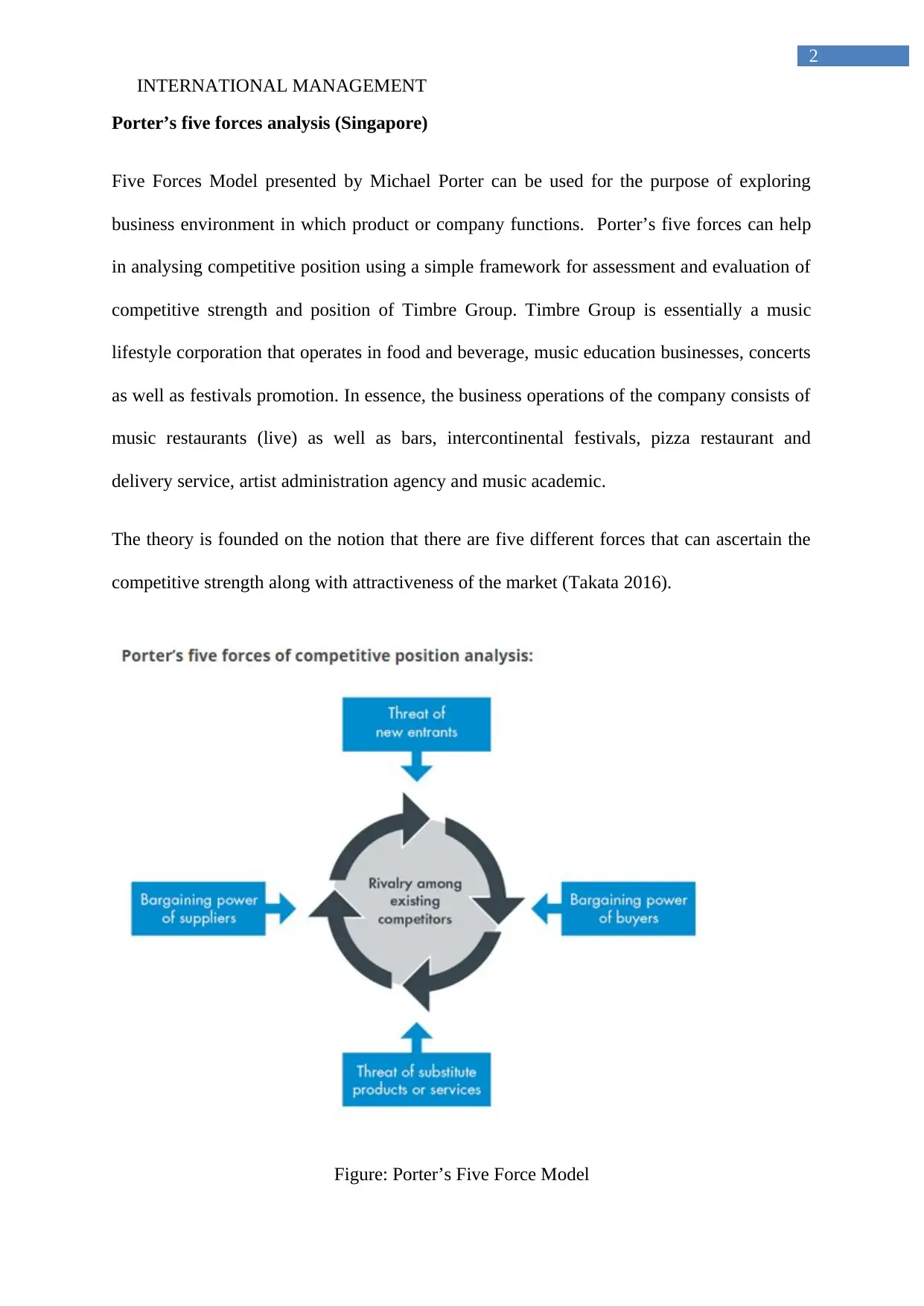
2
INTERNATIONAL MANAGEMENT
Porter’s five forces analysis (Singapore)
Five Forces Model presented by Michael Porter can be used for the purpose of exploring
business environment in which product or company functions. Porter’s five forces can help
in analysing competitive position using a simple framework for assessment and evaluation of
competitive strength and position of Timbre Group. Timbre Group is essentially a music
lifestyle corporation that operates in food and beverage, music education businesses, concerts
as well as festivals promotion. In essence, the business operations of the company consists of
music restaurants (live) as well as bars, intercontinental festivals, pizza restaurant and
delivery service, artist administration agency and music academic.
The theory is founded on the notion that there are five different forces that can ascertain the
competitive strength along with attractiveness of the market (Takata 2016).
Figure: Porter’s Five Force Model
INTERNATIONAL MANAGEMENT
Porter’s five forces analysis (Singapore)
Five Forces Model presented by Michael Porter can be used for the purpose of exploring
business environment in which product or company functions. Porter’s five forces can help
in analysing competitive position using a simple framework for assessment and evaluation of
competitive strength and position of Timbre Group. Timbre Group is essentially a music
lifestyle corporation that operates in food and beverage, music education businesses, concerts
as well as festivals promotion. In essence, the business operations of the company consists of
music restaurants (live) as well as bars, intercontinental festivals, pizza restaurant and
delivery service, artist administration agency and music academic.
The theory is founded on the notion that there are five different forces that can ascertain the
competitive strength along with attractiveness of the market (Takata 2016).
Figure: Porter’s Five Force Model
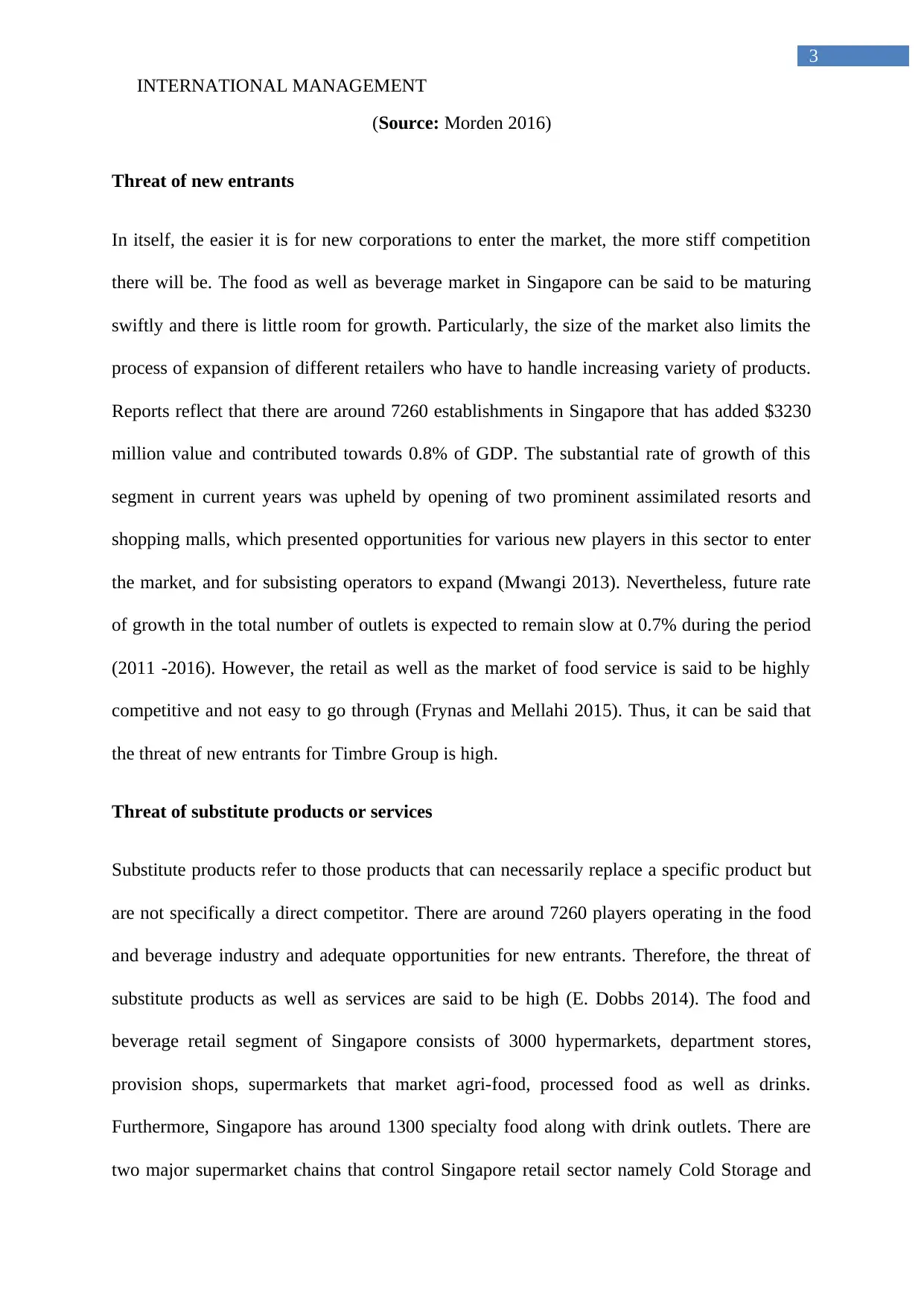
3
INTERNATIONAL MANAGEMENT
(Source: Morden 2016)
Threat of new entrants
In itself, the easier it is for new corporations to enter the market, the more stiff competition
there will be. The food as well as beverage market in Singapore can be said to be maturing
swiftly and there is little room for growth. Particularly, the size of the market also limits the
process of expansion of different retailers who have to handle increasing variety of products.
Reports reflect that there are around 7260 establishments in Singapore that has added $3230
million value and contributed towards 0.8% of GDP. The substantial rate of growth of this
segment in current years was upheld by opening of two prominent assimilated resorts and
shopping malls, which presented opportunities for various new players in this sector to enter
the market, and for subsisting operators to expand (Mwangi 2013). Nevertheless, future rate
of growth in the total number of outlets is expected to remain slow at 0.7% during the period
(2011 -2016). However, the retail as well as the market of food service is said to be highly
competitive and not easy to go through (Frynas and Mellahi 2015). Thus, it can be said that
the threat of new entrants for Timbre Group is high.
Threat of substitute products or services
Substitute products refer to those products that can necessarily replace a specific product but
are not specifically a direct competitor. There are around 7260 players operating in the food
and beverage industry and adequate opportunities for new entrants. Therefore, the threat of
substitute products as well as services are said to be high (E. Dobbs 2014). The food and
beverage retail segment of Singapore consists of 3000 hypermarkets, department stores,
provision shops, supermarkets that market agri-food, processed food as well as drinks.
Furthermore, Singapore has around 1300 specialty food along with drink outlets. There are
two major supermarket chains that control Singapore retail sector namely Cold Storage and
INTERNATIONAL MANAGEMENT
(Source: Morden 2016)
Threat of new entrants
In itself, the easier it is for new corporations to enter the market, the more stiff competition
there will be. The food as well as beverage market in Singapore can be said to be maturing
swiftly and there is little room for growth. Particularly, the size of the market also limits the
process of expansion of different retailers who have to handle increasing variety of products.
Reports reflect that there are around 7260 establishments in Singapore that has added $3230
million value and contributed towards 0.8% of GDP. The substantial rate of growth of this
segment in current years was upheld by opening of two prominent assimilated resorts and
shopping malls, which presented opportunities for various new players in this sector to enter
the market, and for subsisting operators to expand (Mwangi 2013). Nevertheless, future rate
of growth in the total number of outlets is expected to remain slow at 0.7% during the period
(2011 -2016). However, the retail as well as the market of food service is said to be highly
competitive and not easy to go through (Frynas and Mellahi 2015). Thus, it can be said that
the threat of new entrants for Timbre Group is high.
Threat of substitute products or services
Substitute products refer to those products that can necessarily replace a specific product but
are not specifically a direct competitor. There are around 7260 players operating in the food
and beverage industry and adequate opportunities for new entrants. Therefore, the threat of
substitute products as well as services are said to be high (E. Dobbs 2014). The food and
beverage retail segment of Singapore consists of 3000 hypermarkets, department stores,
provision shops, supermarkets that market agri-food, processed food as well as drinks.
Furthermore, Singapore has around 1300 specialty food along with drink outlets. There are
two major supermarket chains that control Singapore retail sector namely Cold Storage and
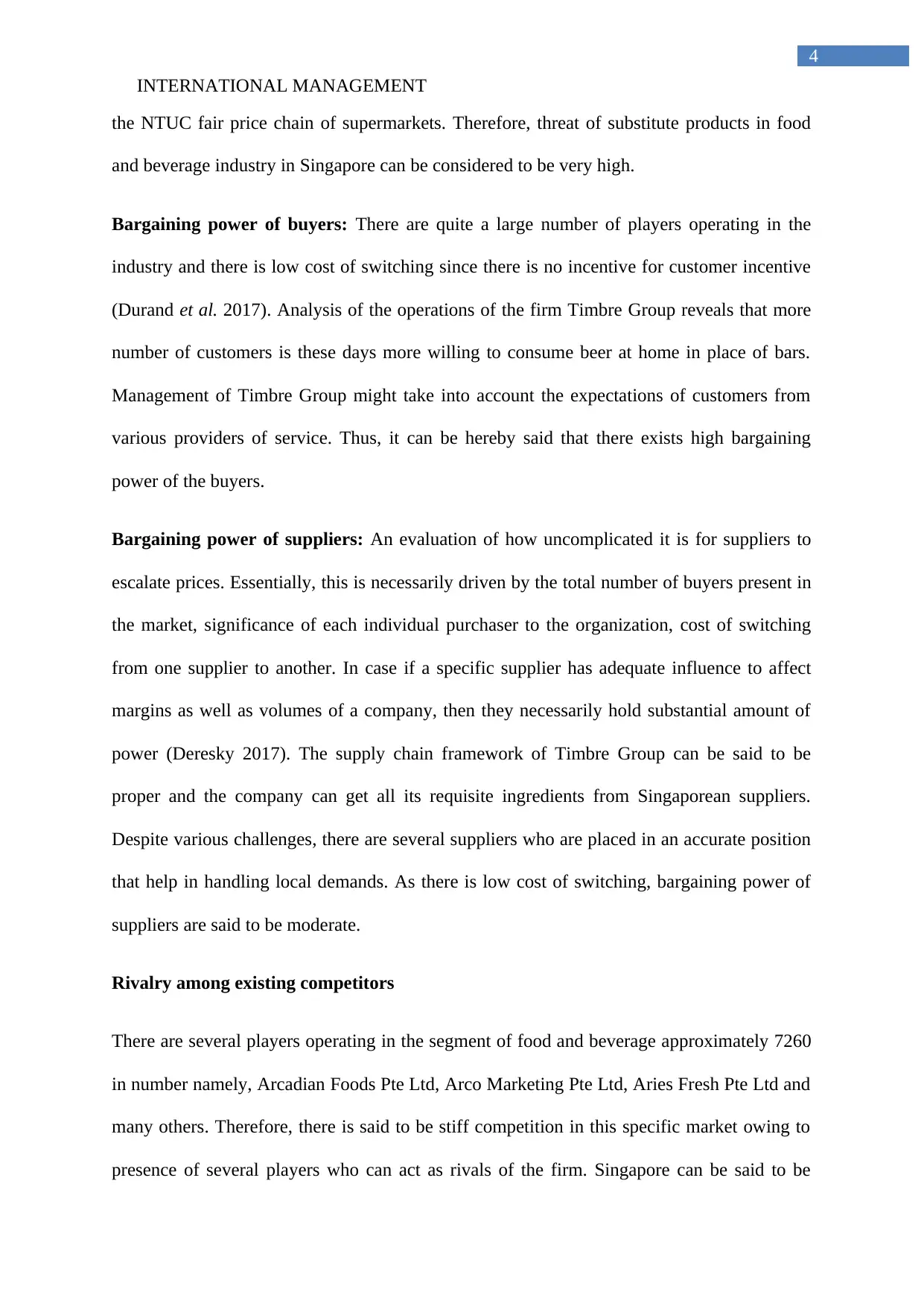
4
INTERNATIONAL MANAGEMENT
the NTUC fair price chain of supermarkets. Therefore, threat of substitute products in food
and beverage industry in Singapore can be considered to be very high.
Bargaining power of buyers: There are quite a large number of players operating in the
industry and there is low cost of switching since there is no incentive for customer incentive
(Durand et al. 2017). Analysis of the operations of the firm Timbre Group reveals that more
number of customers is these days more willing to consume beer at home in place of bars.
Management of Timbre Group might take into account the expectations of customers from
various providers of service. Thus, it can be hereby said that there exists high bargaining
power of the buyers.
Bargaining power of suppliers: An evaluation of how uncomplicated it is for suppliers to
escalate prices. Essentially, this is necessarily driven by the total number of buyers present in
the market, significance of each individual purchaser to the organization, cost of switching
from one supplier to another. In case if a specific supplier has adequate influence to affect
margins as well as volumes of a company, then they necessarily hold substantial amount of
power (Deresky 2017). The supply chain framework of Timbre Group can be said to be
proper and the company can get all its requisite ingredients from Singaporean suppliers.
Despite various challenges, there are several suppliers who are placed in an accurate position
that help in handling local demands. As there is low cost of switching, bargaining power of
suppliers are said to be moderate.
Rivalry among existing competitors
There are several players operating in the segment of food and beverage approximately 7260
in number namely, Arcadian Foods Pte Ltd, Arco Marketing Pte Ltd, Aries Fresh Pte Ltd and
many others. Therefore, there is said to be stiff competition in this specific market owing to
presence of several players who can act as rivals of the firm. Singapore can be said to be
INTERNATIONAL MANAGEMENT
the NTUC fair price chain of supermarkets. Therefore, threat of substitute products in food
and beverage industry in Singapore can be considered to be very high.
Bargaining power of buyers: There are quite a large number of players operating in the
industry and there is low cost of switching since there is no incentive for customer incentive
(Durand et al. 2017). Analysis of the operations of the firm Timbre Group reveals that more
number of customers is these days more willing to consume beer at home in place of bars.
Management of Timbre Group might take into account the expectations of customers from
various providers of service. Thus, it can be hereby said that there exists high bargaining
power of the buyers.
Bargaining power of suppliers: An evaluation of how uncomplicated it is for suppliers to
escalate prices. Essentially, this is necessarily driven by the total number of buyers present in
the market, significance of each individual purchaser to the organization, cost of switching
from one supplier to another. In case if a specific supplier has adequate influence to affect
margins as well as volumes of a company, then they necessarily hold substantial amount of
power (Deresky 2017). The supply chain framework of Timbre Group can be said to be
proper and the company can get all its requisite ingredients from Singaporean suppliers.
Despite various challenges, there are several suppliers who are placed in an accurate position
that help in handling local demands. As there is low cost of switching, bargaining power of
suppliers are said to be moderate.
Rivalry among existing competitors
There are several players operating in the segment of food and beverage approximately 7260
in number namely, Arcadian Foods Pte Ltd, Arco Marketing Pte Ltd, Aries Fresh Pte Ltd and
many others. Therefore, there is said to be stiff competition in this specific market owing to
presence of several players who can act as rivals of the firm. Singapore can be said to be
Secure Best Marks with AI Grader
Need help grading? Try our AI Grader for instant feedback on your assignments.
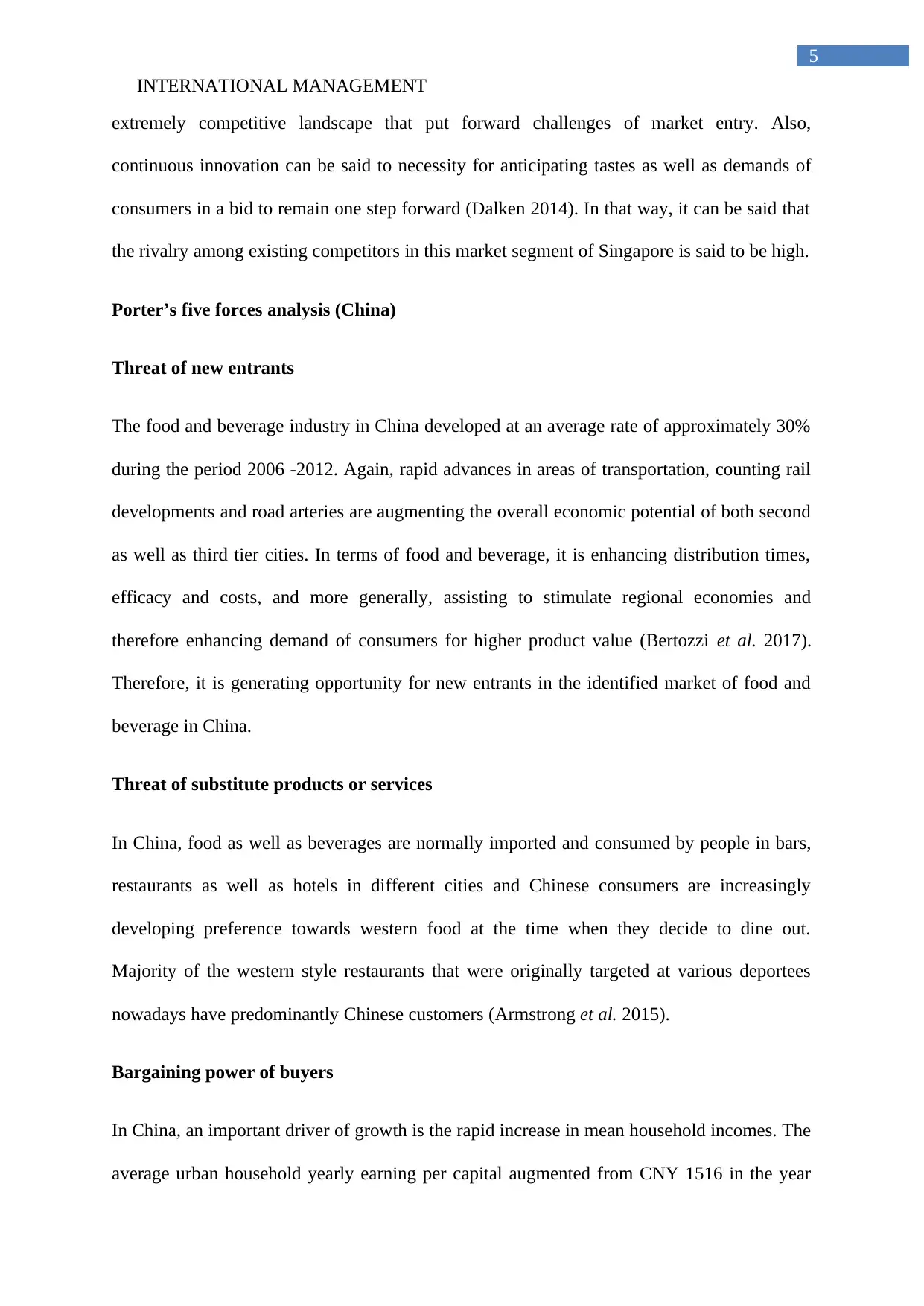
5
INTERNATIONAL MANAGEMENT
extremely competitive landscape that put forward challenges of market entry. Also,
continuous innovation can be said to necessity for anticipating tastes as well as demands of
consumers in a bid to remain one step forward (Dalken 2014). In that way, it can be said that
the rivalry among existing competitors in this market segment of Singapore is said to be high.
Porter’s five forces analysis (China)
Threat of new entrants
The food and beverage industry in China developed at an average rate of approximately 30%
during the period 2006 -2012. Again, rapid advances in areas of transportation, counting rail
developments and road arteries are augmenting the overall economic potential of both second
as well as third tier cities. In terms of food and beverage, it is enhancing distribution times,
efficacy and costs, and more generally, assisting to stimulate regional economies and
therefore enhancing demand of consumers for higher product value (Bertozzi et al. 2017).
Therefore, it is generating opportunity for new entrants in the identified market of food and
beverage in China.
Threat of substitute products or services
In China, food as well as beverages are normally imported and consumed by people in bars,
restaurants as well as hotels in different cities and Chinese consumers are increasingly
developing preference towards western food at the time when they decide to dine out.
Majority of the western style restaurants that were originally targeted at various deportees
nowadays have predominantly Chinese customers (Armstrong et al. 2015).
Bargaining power of buyers
In China, an important driver of growth is the rapid increase in mean household incomes. The
average urban household yearly earning per capital augmented from CNY 1516 in the year
INTERNATIONAL MANAGEMENT
extremely competitive landscape that put forward challenges of market entry. Also,
continuous innovation can be said to necessity for anticipating tastes as well as demands of
consumers in a bid to remain one step forward (Dalken 2014). In that way, it can be said that
the rivalry among existing competitors in this market segment of Singapore is said to be high.
Porter’s five forces analysis (China)
Threat of new entrants
The food and beverage industry in China developed at an average rate of approximately 30%
during the period 2006 -2012. Again, rapid advances in areas of transportation, counting rail
developments and road arteries are augmenting the overall economic potential of both second
as well as third tier cities. In terms of food and beverage, it is enhancing distribution times,
efficacy and costs, and more generally, assisting to stimulate regional economies and
therefore enhancing demand of consumers for higher product value (Bertozzi et al. 2017).
Therefore, it is generating opportunity for new entrants in the identified market of food and
beverage in China.
Threat of substitute products or services
In China, food as well as beverages are normally imported and consumed by people in bars,
restaurants as well as hotels in different cities and Chinese consumers are increasingly
developing preference towards western food at the time when they decide to dine out.
Majority of the western style restaurants that were originally targeted at various deportees
nowadays have predominantly Chinese customers (Armstrong et al. 2015).
Bargaining power of buyers
In China, an important driver of growth is the rapid increase in mean household incomes. The
average urban household yearly earning per capital augmented from CNY 1516 in the year
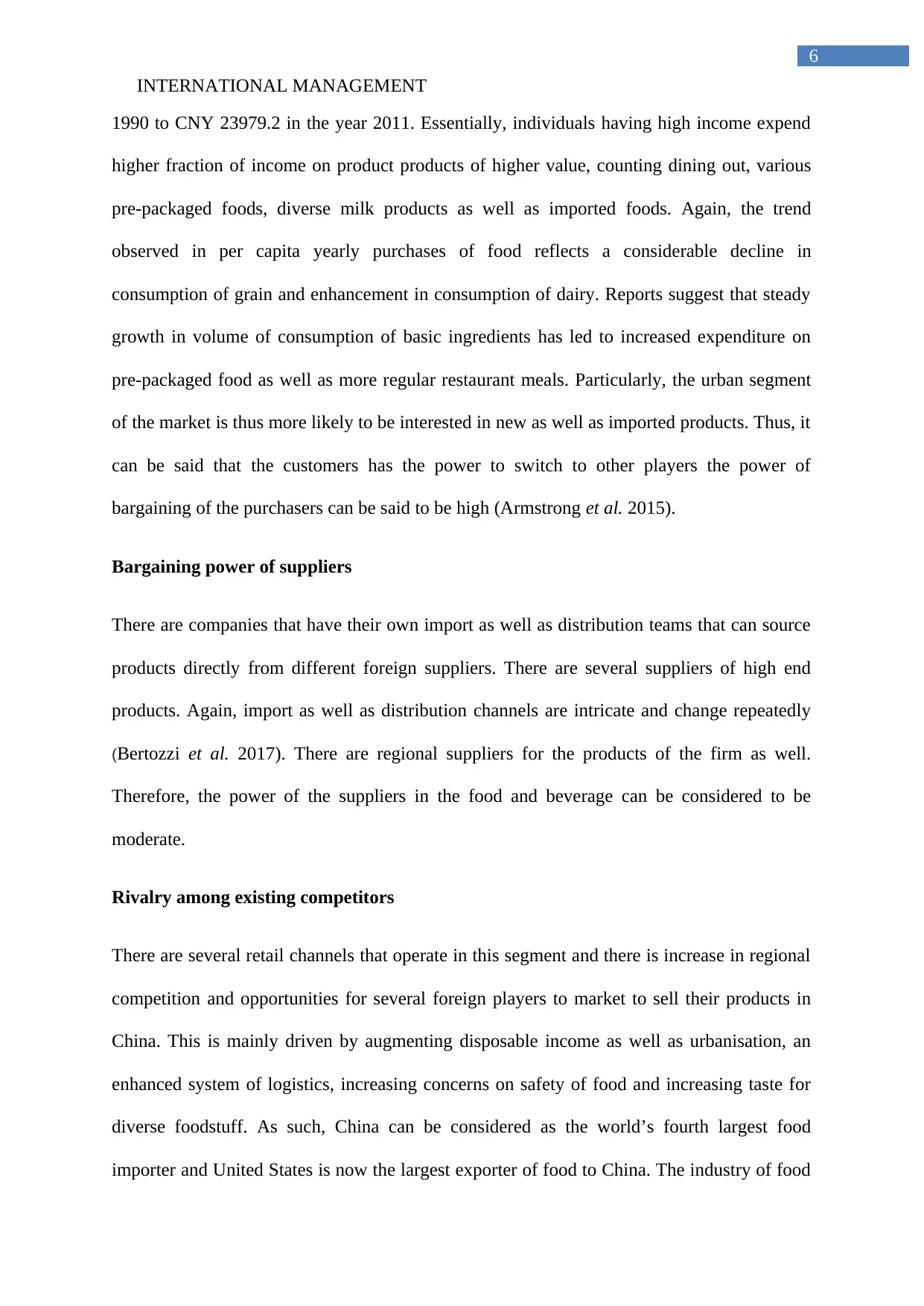
6
INTERNATIONAL MANAGEMENT
1990 to CNY 23979.2 in the year 2011. Essentially, individuals having high income expend
higher fraction of income on product products of higher value, counting dining out, various
pre-packaged foods, diverse milk products as well as imported foods. Again, the trend
observed in per capita yearly purchases of food reflects a considerable decline in
consumption of grain and enhancement in consumption of dairy. Reports suggest that steady
growth in volume of consumption of basic ingredients has led to increased expenditure on
pre-packaged food as well as more regular restaurant meals. Particularly, the urban segment
of the market is thus more likely to be interested in new as well as imported products. Thus, it
can be said that the customers has the power to switch to other players the power of
bargaining of the purchasers can be said to be high (Armstrong et al. 2015).
Bargaining power of suppliers
There are companies that have their own import as well as distribution teams that can source
products directly from different foreign suppliers. There are several suppliers of high end
products. Again, import as well as distribution channels are intricate and change repeatedly
(Bertozzi et al. 2017). There are regional suppliers for the products of the firm as well.
Therefore, the power of the suppliers in the food and beverage can be considered to be
moderate.
Rivalry among existing competitors
There are several retail channels that operate in this segment and there is increase in regional
competition and opportunities for several foreign players to market to sell their products in
China. This is mainly driven by augmenting disposable income as well as urbanisation, an
enhanced system of logistics, increasing concerns on safety of food and increasing taste for
diverse foodstuff. As such, China can be considered as the world’s fourth largest food
importer and United States is now the largest exporter of food to China. The industry of food
INTERNATIONAL MANAGEMENT
1990 to CNY 23979.2 in the year 2011. Essentially, individuals having high income expend
higher fraction of income on product products of higher value, counting dining out, various
pre-packaged foods, diverse milk products as well as imported foods. Again, the trend
observed in per capita yearly purchases of food reflects a considerable decline in
consumption of grain and enhancement in consumption of dairy. Reports suggest that steady
growth in volume of consumption of basic ingredients has led to increased expenditure on
pre-packaged food as well as more regular restaurant meals. Particularly, the urban segment
of the market is thus more likely to be interested in new as well as imported products. Thus, it
can be said that the customers has the power to switch to other players the power of
bargaining of the purchasers can be said to be high (Armstrong et al. 2015).
Bargaining power of suppliers
There are companies that have their own import as well as distribution teams that can source
products directly from different foreign suppliers. There are several suppliers of high end
products. Again, import as well as distribution channels are intricate and change repeatedly
(Bertozzi et al. 2017). There are regional suppliers for the products of the firm as well.
Therefore, the power of the suppliers in the food and beverage can be considered to be
moderate.
Rivalry among existing competitors
There are several retail channels that operate in this segment and there is increase in regional
competition and opportunities for several foreign players to market to sell their products in
China. This is mainly driven by augmenting disposable income as well as urbanisation, an
enhanced system of logistics, increasing concerns on safety of food and increasing taste for
diverse foodstuff. As such, China can be considered as the world’s fourth largest food
importer and United States is now the largest exporter of food to China. The industry of food
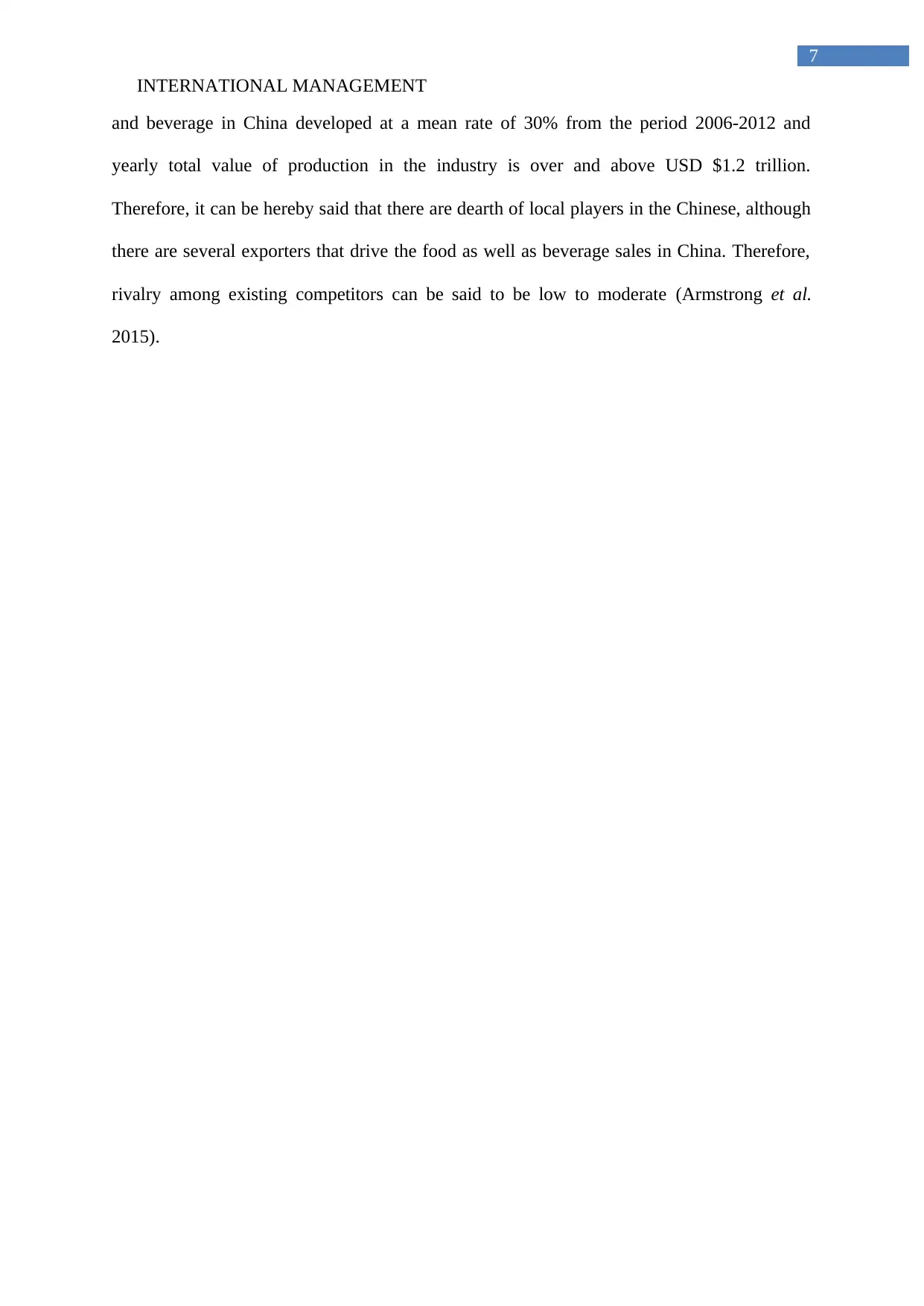
7
INTERNATIONAL MANAGEMENT
and beverage in China developed at a mean rate of 30% from the period 2006-2012 and
yearly total value of production in the industry is over and above USD $1.2 trillion.
Therefore, it can be hereby said that there are dearth of local players in the Chinese, although
there are several exporters that drive the food as well as beverage sales in China. Therefore,
rivalry among existing competitors can be said to be low to moderate (Armstrong et al.
2015).
INTERNATIONAL MANAGEMENT
and beverage in China developed at a mean rate of 30% from the period 2006-2012 and
yearly total value of production in the industry is over and above USD $1.2 trillion.
Therefore, it can be hereby said that there are dearth of local players in the Chinese, although
there are several exporters that drive the food as well as beverage sales in China. Therefore,
rivalry among existing competitors can be said to be low to moderate (Armstrong et al.
2015).
Paraphrase This Document
Need a fresh take? Get an instant paraphrase of this document with our AI Paraphraser
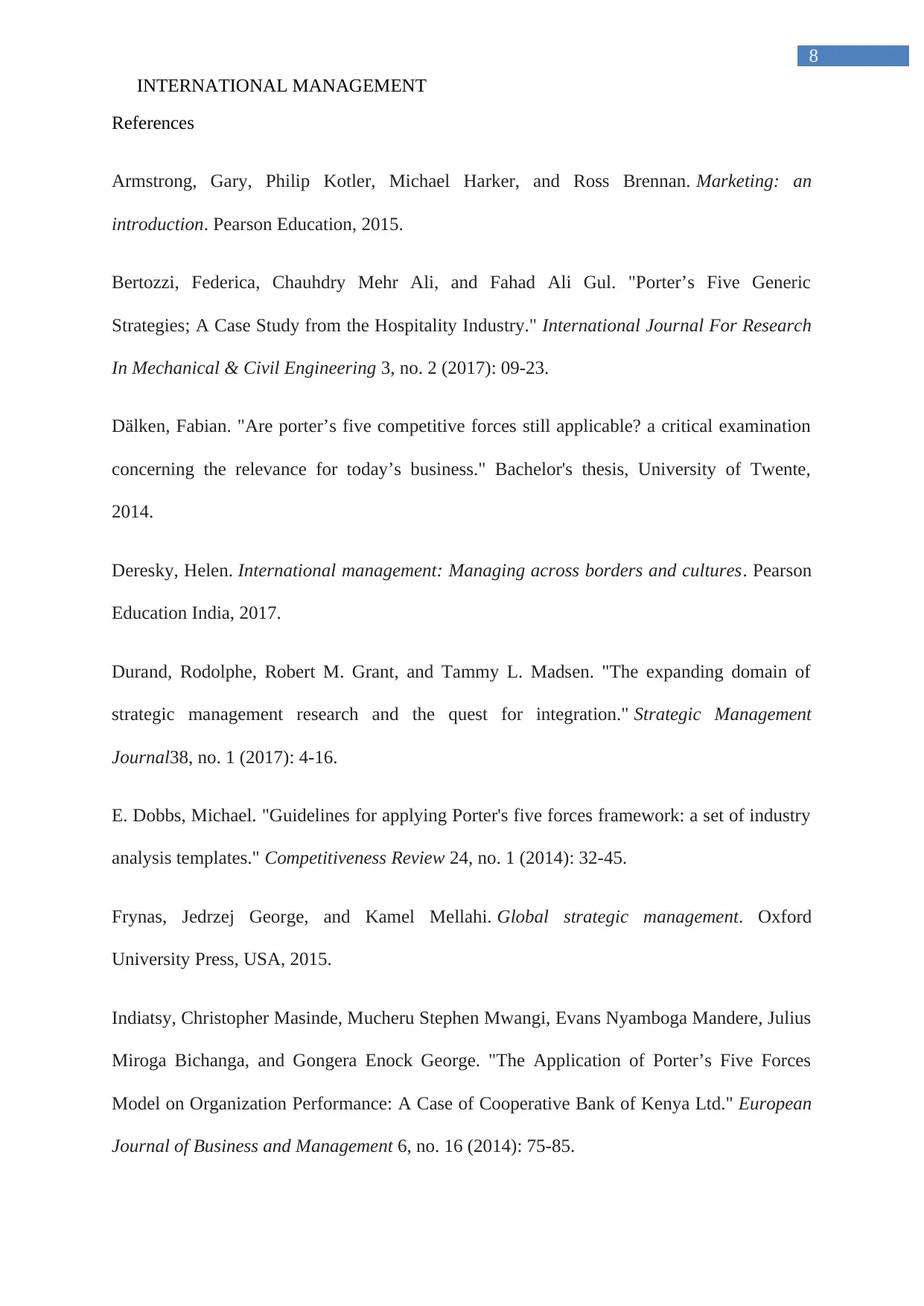
8
INTERNATIONAL MANAGEMENT
References
Armstrong, Gary, Philip Kotler, Michael Harker, and Ross Brennan. Marketing: an
introduction. Pearson Education, 2015.
Bertozzi, Federica, Chauhdry Mehr Ali, and Fahad Ali Gul. "Porter’s Five Generic
Strategies; A Case Study from the Hospitality Industry." International Journal For Research
In Mechanical & Civil Engineering 3, no. 2 (2017): 09-23.
Dälken, Fabian. "Are porter’s five competitive forces still applicable? a critical examination
concerning the relevance for today’s business." Bachelor's thesis, University of Twente,
2014.
Deresky, Helen. International management: Managing across borders and cultures. Pearson
Education India, 2017.
Durand, Rodolphe, Robert M. Grant, and Tammy L. Madsen. "The expanding domain of
strategic management research and the quest for integration." Strategic Management
Journal38, no. 1 (2017): 4-16.
E. Dobbs, Michael. "Guidelines for applying Porter's five forces framework: a set of industry
analysis templates." Competitiveness Review 24, no. 1 (2014): 32-45.
Frynas, Jedrzej George, and Kamel Mellahi. Global strategic management. Oxford
University Press, USA, 2015.
Indiatsy, Christopher Masinde, Mucheru Stephen Mwangi, Evans Nyamboga Mandere, Julius
Miroga Bichanga, and Gongera Enock George. "The Application of Porter’s Five Forces
Model on Organization Performance: A Case of Cooperative Bank of Kenya Ltd." European
Journal of Business and Management 6, no. 16 (2014): 75-85.
INTERNATIONAL MANAGEMENT
References
Armstrong, Gary, Philip Kotler, Michael Harker, and Ross Brennan. Marketing: an
introduction. Pearson Education, 2015.
Bertozzi, Federica, Chauhdry Mehr Ali, and Fahad Ali Gul. "Porter’s Five Generic
Strategies; A Case Study from the Hospitality Industry." International Journal For Research
In Mechanical & Civil Engineering 3, no. 2 (2017): 09-23.
Dälken, Fabian. "Are porter’s five competitive forces still applicable? a critical examination
concerning the relevance for today’s business." Bachelor's thesis, University of Twente,
2014.
Deresky, Helen. International management: Managing across borders and cultures. Pearson
Education India, 2017.
Durand, Rodolphe, Robert M. Grant, and Tammy L. Madsen. "The expanding domain of
strategic management research and the quest for integration." Strategic Management
Journal38, no. 1 (2017): 4-16.
E. Dobbs, Michael. "Guidelines for applying Porter's five forces framework: a set of industry
analysis templates." Competitiveness Review 24, no. 1 (2014): 32-45.
Frynas, Jedrzej George, and Kamel Mellahi. Global strategic management. Oxford
University Press, USA, 2015.
Indiatsy, Christopher Masinde, Mucheru Stephen Mwangi, Evans Nyamboga Mandere, Julius
Miroga Bichanga, and Gongera Enock George. "The Application of Porter’s Five Forces
Model on Organization Performance: A Case of Cooperative Bank of Kenya Ltd." European
Journal of Business and Management 6, no. 16 (2014): 75-85.
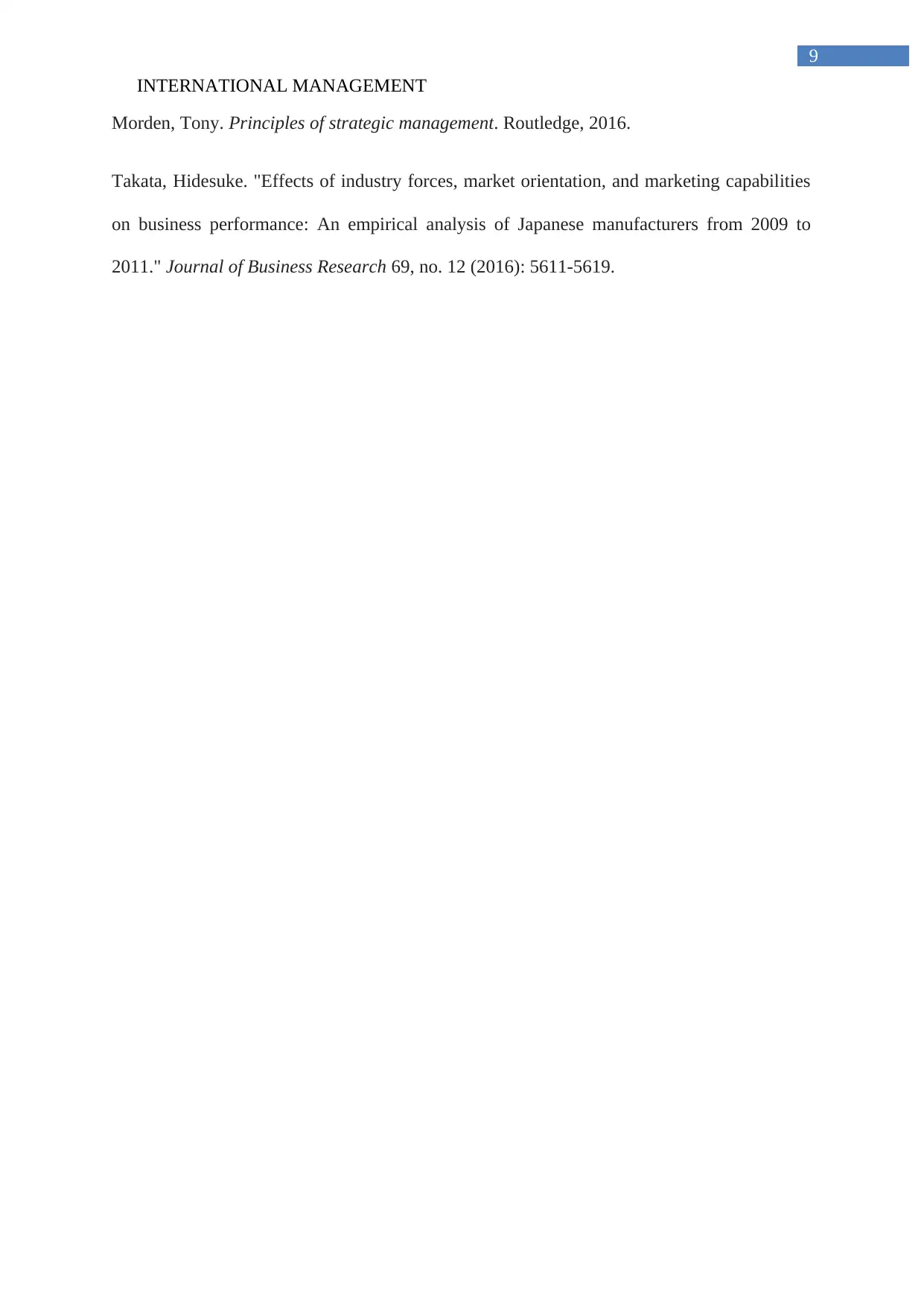
9
INTERNATIONAL MANAGEMENT
Morden, Tony. Principles of strategic management. Routledge, 2016.
Takata, Hidesuke. "Effects of industry forces, market orientation, and marketing capabilities
on business performance: An empirical analysis of Japanese manufacturers from 2009 to
2011." Journal of Business Research 69, no. 12 (2016): 5611-5619.
INTERNATIONAL MANAGEMENT
Morden, Tony. Principles of strategic management. Routledge, 2016.
Takata, Hidesuke. "Effects of industry forces, market orientation, and marketing capabilities
on business performance: An empirical analysis of Japanese manufacturers from 2009 to
2011." Journal of Business Research 69, no. 12 (2016): 5611-5619.
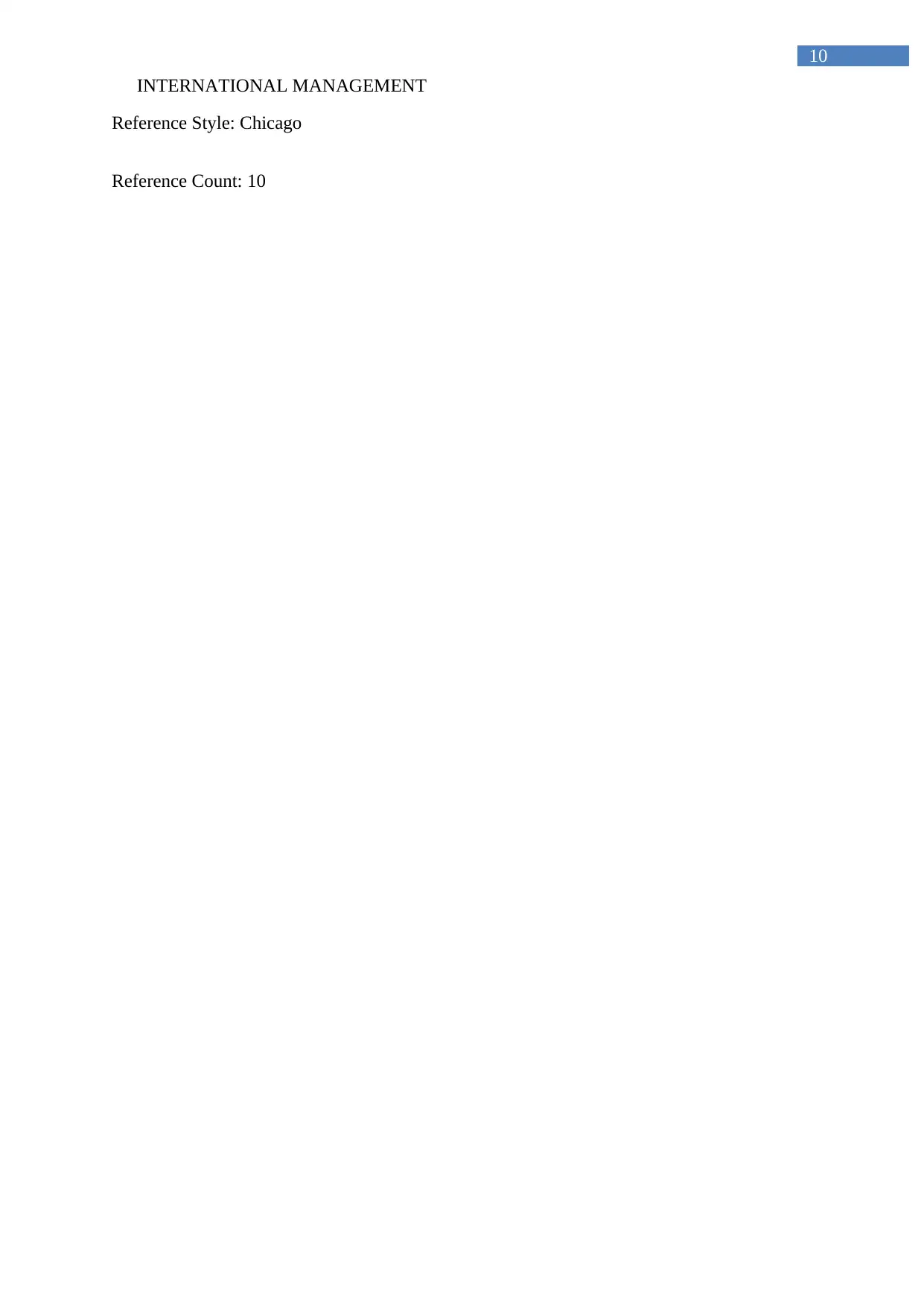
10
INTERNATIONAL MANAGEMENT
Reference Style: Chicago
Reference Count: 10
INTERNATIONAL MANAGEMENT
Reference Style: Chicago
Reference Count: 10
1 out of 10
Related Documents
Your All-in-One AI-Powered Toolkit for Academic Success.
+13062052269
info@desklib.com
Available 24*7 on WhatsApp / Email
![[object Object]](/_next/static/media/star-bottom.7253800d.svg)
Unlock your academic potential
© 2024 | Zucol Services PVT LTD | All rights reserved.





